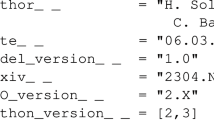Abstract
I trace the evolution of the scientific world view in general and of the variational approach specifically, including transformation groups I then review the impact of these ideas at the atomic, nuclear and particle levels.
Similar content being viewed by others
References
Y. Ne’eman, “Plato and the Self-Geometrization of Physics in the Twentieth Century”, in Functional Differential Equations 5 (1998) #3-4, p. 19–34. (Talk delivered at the International Conf. on Diff. Eqs., Ariel, Israel, 1998).
Y. Ne’eman, “Insight and Foresight in Physics: From Plato and Aristotle to Einstein and the Standard Model”, in Nuclear Matter, Hot and Cold (Proc. Tel-Aviv Conf. In Mem. of Judah Eisenberg, April 1999), J. alster and D. Ashery, eds., Tel-Aviv Univ. Pub., 2000, 286 pp., p. 12–22.
Y. Ne’eman, “Pythagorean and Platonic Conceptions in XXth Century Physics”, in Visions in Mathematics 2000, V. Milman et al., eds. GAFA, Geom. Funct. Anal., Birkhäuser Verlag, Basel, 2000, p. 383–405.
W. Yourgrou and S. Mandelstam, Variational Principles in Dynamics and Quantum Theory, Dover Pub., New York 1968, 201 pp.
See for example G. t’Hooft and M. Veltman, Diagammar, CERN TH 73-9.
H.A. Kastrup, in Symmetries in Physics (1600–1980), M.G. Doncel, ed., Univ. Barcelona Pub. (1987) 113–164.
E. Noether, Nach. d. Kgl. Ges. d. Wiss., Math. Phys. Klass. 2 (1918) 17.
H. Weyl, Zeit. Physik 56 (1921) 350.
C.N. Yang and R.L. Mills, Phys. Rev. 96 (1954) 191.
H. Weyl, “Preface”, in The Theory of Groups and Quantum Mechanics, 2nd revsd German edition.
E.E. Helm, “The Vibrating String of the Pythagoreans”, Scientific Amer. 217 (Dec. 1967) 92–103.
W. Thomson, Baron Kelvin, “Dark Clouds over XIXth Century Physics”, The Philosophical Magazine and J. of Sci. II, 6th series (1901) 1–31.
E. Wigner, “On Unitary Representations of the Inhomogeneous Lorentz Group, “Ann. Math. 40 (1939) 149–204.
M.A. Naimark, Uspekhi Mat. Nauk 9 (1954) 19.
V. Bargmann and E. Wigner, “Group theoretical Discussion of Relativistic Wave Equations”, P.N.A.S. USA 34 (1946) 211–223.
E. Wigner, “On the Consequences of the Symmetry of the Nuclear Hamiltonian on the Spectroscopy of Nuclei”, Phys. Rev. 51 (1937) 106–119.
Y. Ne’eman, “Derivation of Strong Interactions from a Gauge Invariance”, Nucl. Phys. 26 (1961) 222–229.
E. Wigner, Symmetries and Reflections, Ox Bow Press, Woodridge Course, 1979, p. 24.
F. Gürsey and L.A. Radicati, “Spin and Unitary Spin Independence of Strong Interactions”, Phys. Rev. Lett. 13 (1964) 173–175.
E.M. Levin and L.L. Frankfurt, JETP Lett. 2 (1965) 105–108.
F. Gürsey, A. Pais and L.A. Radicati, “Spin and Unitary Spin of Strong Interactions”, Phys. Rev. Lett. 13 (1964) 299–301.
H. Goldberg and Y. Ne’eman, “Baryon Charge and R-Inversion in the Octet Model”, Nuovo Cimento 27 (1963) 1–5.
E. Wigner, “Epistemology of Quantum Mechanics”, in Contemporary Physics, Trieste Symp., 1968, A. Salam and L. Fonda, eds., IAEC pub., Vol. II, 431–437.
G. Marx, The Voice of the Martians, Akadémiai Kiadó, Budapest, 1994, 414 pp.
Y. Ne’eman, “Edward Teller, the Hungarian, American and Jew, too”, Heavy Ion Phys. 7 (1998) 155–165.
Y. Ne’eman, “Elementary Constituents — Fields or Particle States?” Heavy Ion Phys. 3 (1996) 131–134. Hungarian translation in Fizikai Szemle XLV (1995) 330–331.
Author information
Authors and Affiliations
Rights and permissions
About this article
Cite this article
Ne’eman, Y. Symmetry and “Magic” Numbers or from the pythagoreans to Eugene Wigner. Acta Phys. Hung. A 19, 241–246 (2004). https://doi.org/10.1556/APH.19.2004.3-4.14
Received:
Issue Date:
DOI: https://doi.org/10.1556/APH.19.2004.3-4.14
Keywords
- symmetry
- laws of nature
- variational calculus
- action principle
- Pythagoreanism
- path-integral
- Noether theorems
- music of the spheres




